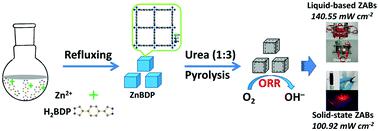Our official English website, www.x-mol.net, welcomes your
feedback! (Note: you will need to create a separate account there.)
N- and O-doped hollow carbons constructed by self- and extrinsic activation for the oxygen reduction reaction and flexible zinc–air Batteries
Nanoscale ( IF 5.8 ) Pub Date : 2021-09-08 , DOI: 10.1039/d1nr04821j Qianjie Xie 1, 2 , Wenfang Si 2 , Yehua Shen 2 , Zheng Wang 1 , Hiroshi Uyama 2, 3
Nanoscale ( IF 5.8 ) Pub Date : 2021-09-08 , DOI: 10.1039/d1nr04821j Qianjie Xie 1, 2 , Wenfang Si 2 , Yehua Shen 2 , Zheng Wang 1 , Hiroshi Uyama 2, 3
Affiliation

|
Zinc–air batteries (ZAB), especially those assembled on flexible substrates, have attracted great research attention in electronics and wearable electronics. However, the air–cathode reaction–oxygen reduction reaction (ORR) has limited the development of ZAB technology. In this study, a hollow carbon catalyst, NOC-1000-1, was prepared by pyrolysis of a mixture of a N-enriched Zn/bispyrozolate-based metal–organic framework and urea to replace the labile Pt-based catalysts for ORR. The employment of sacrifical urea eliminated the requirement for complicated post-treatment compared to the template method. Combined with self-activation (Zn evaporation), the obtained carbon showed a micro- and mesopore-dominant hierarchical structure coexisting with some macropores. Moreover, the doped N and O species were also tailored in a preferable configuration for ORR by simply screening the pyrolysis conditions. Under the synergistic effect of the preferable N and O configurations and pore structure, the derived carbon catalyst displayed superior ORR activity of 0.977 V onset potential and 0.867 V half-wave potential; these values are slightly better than those of the 20% Pt/C benchmark catalyst (0.985 and 0.861 V, respectively). Flexible solid-state ZABs were further assembled by employing the derived carbon catalyst as an air-cathode, and they exhibited a higher peak power density of 100.92 mW cm−2 than a 20% Pt/C—RuO2 battery as well as previously reported similar batteries and very high stability for up to 30 h. The flexible solid-state ZABs could drive a red light-emitting diode and run a 130-type motor for hours, which indicates their promising applications in real-world technologies.
中文翻译:

通过自激活和外激活构建的 N 和 O 掺杂的空心碳用于氧还原反应和柔性锌空气电池
锌空气电池(ZAB),尤其是组装在柔性基板上的电池,在电子和可穿戴电子领域引起了极大的研究关注。然而,空气-阴极反应-氧还原反应(ORR)限制了ZAB技术的发展。在这项研究中,中空碳催化剂 NOC-1000-1 是通过热解富氮 Zn/双吡唑啉基金属有机骨架和尿素的混合物制备的,以取代不稳定的 Pt 基催化剂用于 ORR。与模板方法相比,牺牲尿素的使用消除了对复杂后处理的要求。结合自活化(Zn 蒸发),获得的碳显示出以微孔和中孔为主的分级结构,并与一些大孔共存。而且,通过简单地筛选热解条件,掺杂的 N 和 O 物种也被定制为 ORR 的优选配置。在优选的N和O构型和孔结构的协同作用下,衍生的碳催化剂表现出优异的ORR活性,起始电位为0.977 V,半波电位为0.867 V;这些值略好于 20% Pt/C 基准催化剂的值(分别为 0.985 和 0.861 V)。通过使用衍生的碳催化剂作为空气阴极,进一步组装了柔性固态 ZAB,它们表现出更高的峰值功率密度,为 100.92 mW cm 867 V 半波电位;这些值略好于 20% Pt/C 基准催化剂的值(分别为 0.985 和 0.861 V)。通过使用衍生的碳催化剂作为空气阴极,进一步组装了柔性固态 ZAB,它们表现出更高的峰值功率密度,为 100.92 mW cm 867 V 半波电位;这些值略好于 20% Pt/C 基准催化剂的值(分别为 0.985 和 0.861 V)。通过使用衍生的碳催化剂作为空气阴极,进一步组装了柔性固态 ZAB,它们表现出更高的峰值功率密度,为 100.92 mW cm-2比 20% Pt/C-RuO 2电池以及之前报道的类似电池和高达 30 小时的非常高的稳定性。灵活的固态 ZAB 可以驱动红色发光二极管并运行 130 型电机数小时,这表明它们在现实技术中的应用前景广阔。
更新日期:2021-09-24
中文翻译:

通过自激活和外激活构建的 N 和 O 掺杂的空心碳用于氧还原反应和柔性锌空气电池
锌空气电池(ZAB),尤其是组装在柔性基板上的电池,在电子和可穿戴电子领域引起了极大的研究关注。然而,空气-阴极反应-氧还原反应(ORR)限制了ZAB技术的发展。在这项研究中,中空碳催化剂 NOC-1000-1 是通过热解富氮 Zn/双吡唑啉基金属有机骨架和尿素的混合物制备的,以取代不稳定的 Pt 基催化剂用于 ORR。与模板方法相比,牺牲尿素的使用消除了对复杂后处理的要求。结合自活化(Zn 蒸发),获得的碳显示出以微孔和中孔为主的分级结构,并与一些大孔共存。而且,通过简单地筛选热解条件,掺杂的 N 和 O 物种也被定制为 ORR 的优选配置。在优选的N和O构型和孔结构的协同作用下,衍生的碳催化剂表现出优异的ORR活性,起始电位为0.977 V,半波电位为0.867 V;这些值略好于 20% Pt/C 基准催化剂的值(分别为 0.985 和 0.861 V)。通过使用衍生的碳催化剂作为空气阴极,进一步组装了柔性固态 ZAB,它们表现出更高的峰值功率密度,为 100.92 mW cm 867 V 半波电位;这些值略好于 20% Pt/C 基准催化剂的值(分别为 0.985 和 0.861 V)。通过使用衍生的碳催化剂作为空气阴极,进一步组装了柔性固态 ZAB,它们表现出更高的峰值功率密度,为 100.92 mW cm 867 V 半波电位;这些值略好于 20% Pt/C 基准催化剂的值(分别为 0.985 和 0.861 V)。通过使用衍生的碳催化剂作为空气阴极,进一步组装了柔性固态 ZAB,它们表现出更高的峰值功率密度,为 100.92 mW cm-2比 20% Pt/C-RuO 2电池以及之前报道的类似电池和高达 30 小时的非常高的稳定性。灵活的固态 ZAB 可以驱动红色发光二极管并运行 130 型电机数小时,这表明它们在现实技术中的应用前景广阔。











































 京公网安备 11010802027423号
京公网安备 11010802027423号